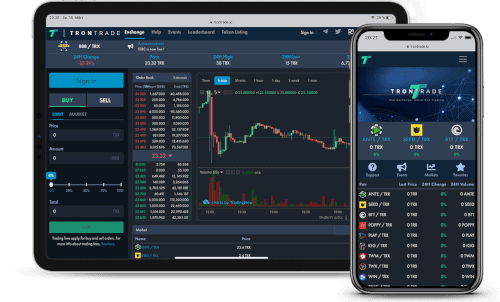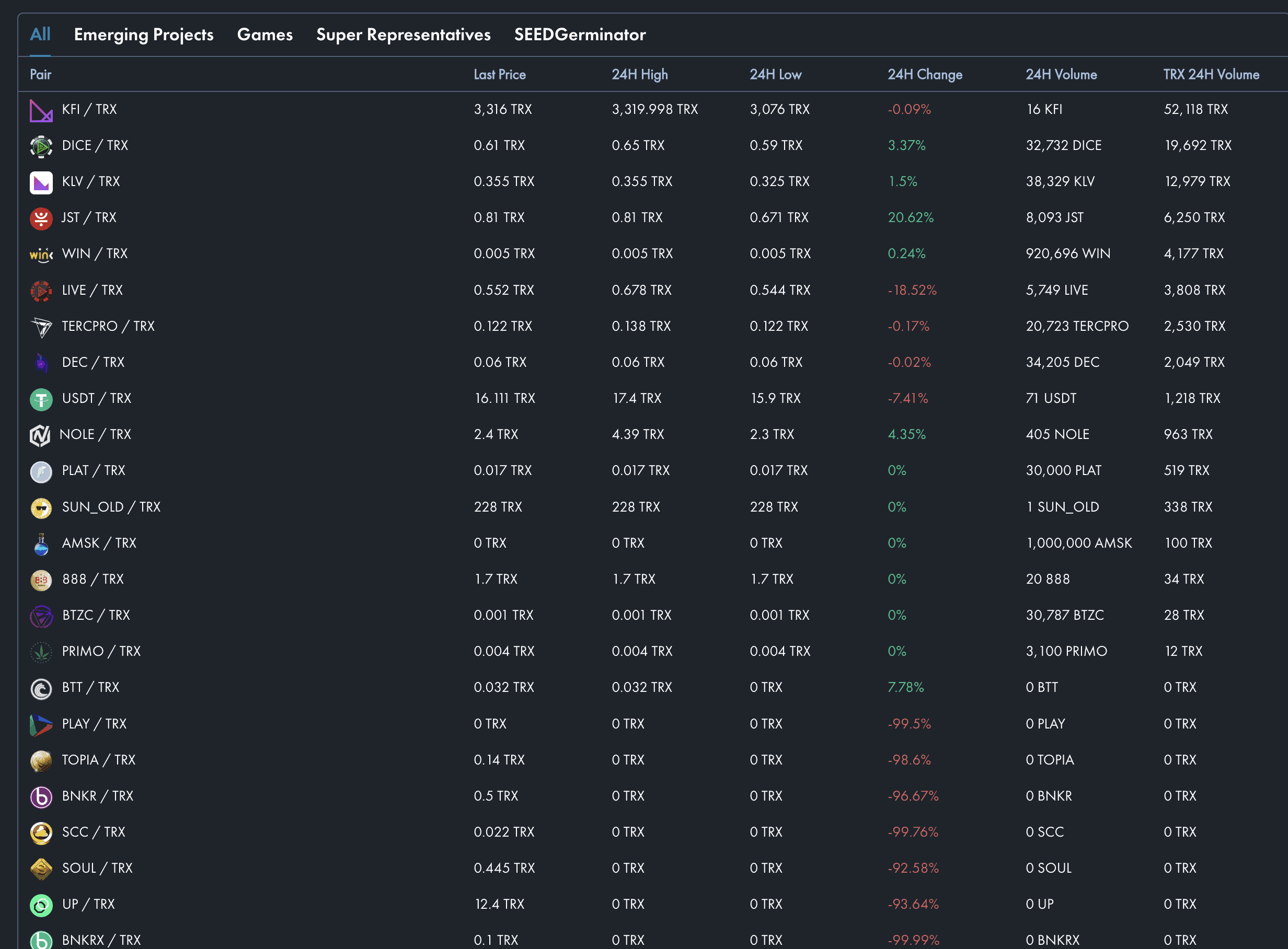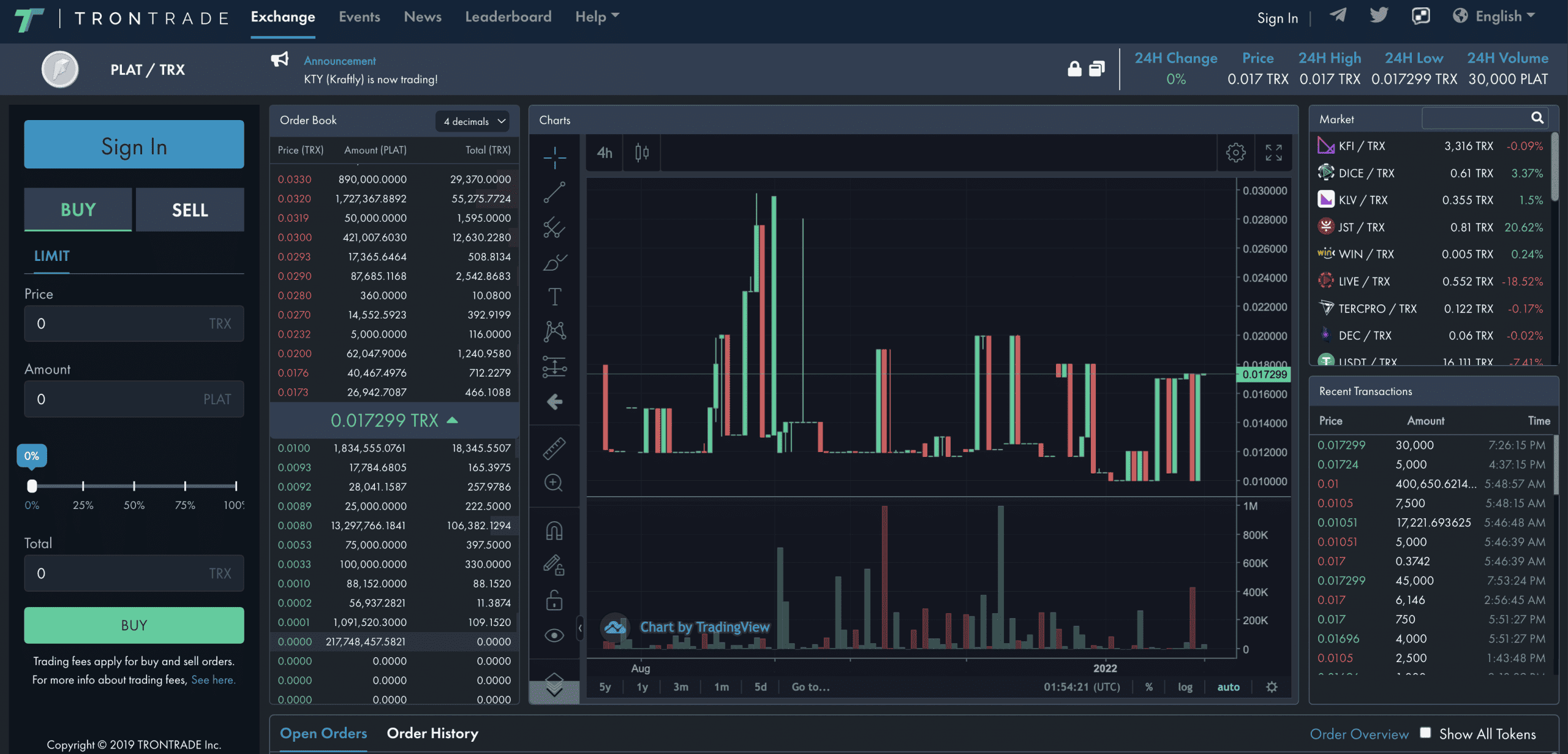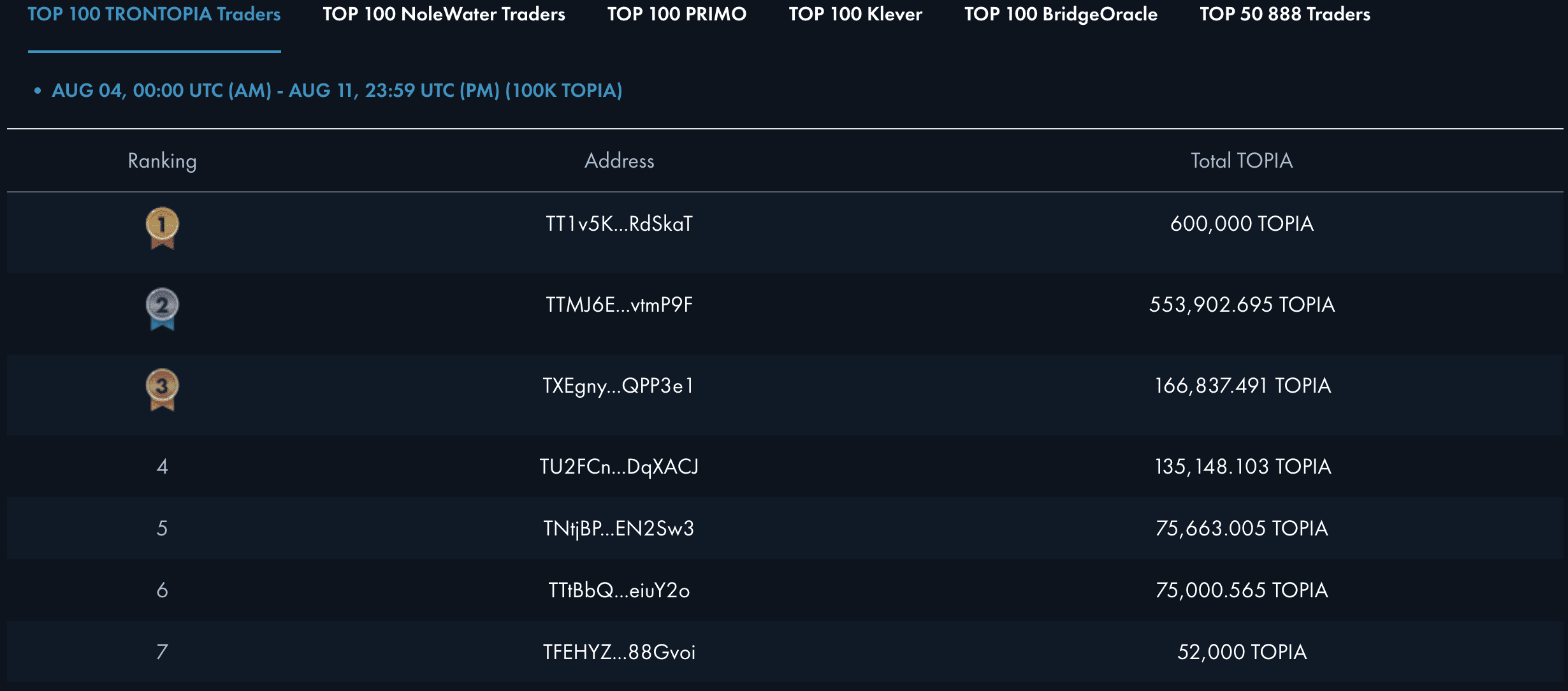
TronTrade is a decentralized cryptocurrency exchange that uses the TRX (Tron) token for trading pairs as its base currency.
Being a decentralized exchange, TronTrade does not require KYC (Know Your Customer) identity verification protocols to be completed for use of the exchange. US users can use the exchange for full access without restrictions.
History of TronTrade
The mission of TronTrade is stated as being an avenue for the adoption of cryptocurrencies by simplifying the process of buying and selling TRC-issued tokens. TRC tokens are those issued on the Tron blockchain network.
The platform offers listed TRC10 and TRC20 tokens, offers only TRX (Tron) as the base trading pair, connects with decentralized web3 wallets that use the TRX blockchain, and also offers 24/7 technical support and a strong community focus.
TronTrade was launched in late 2018, and in Sept 2021, the exchange activity rose to around 3000 daily active unique wallets, up from 1300 in early 2020. Activity on TronTrade has been heavily influenced by the value of TRON-based tokens. The exchange was created by BitGuild, which was a game developer on Ethereum. Access to TronTrade requires the use of either the TronLink or GuildWallet browser extensions.
TronTrade is best for:
-
TRX (Tron) blockchain based cryptocurrency investors and spot traders who wish to trade TRC-based tokens in a permissionless DEX
PROS
- Responsive support team
- Decentralized, permissionless
- Integrated charting
- Advanced order types
- No restrictions on jurisdiction
- No trading limits
CONS
- Only TRX ecosystem
- Only spot trading
- Flat maker-taker fee model
- Some knowledge of TRX blockchain required
Pros & Unique Features
The main innovative and unique features of Trontrade if compared to other DEXs (decentralized exchanges) are its responsive support team that is available 24/7 on Telegram.
Since TronTrade is a permissionless DEX and not a centralized exchange, users retain custody of their assets at all times, using non-custodial wallets such as Metamask. However, in the case of using TronTrade, users must connect using TRX-based wallets such as TronLink or GuildWallet.
TronTrade offers 16 coins and 21 trading pairs, all of which are based on TRX being the base pair, and all offerings are TRC10 and TRC20 tokens in the TRX ecosystem. Only spot trading functionality is offered, with no features for margin or futures.
Though it is a DEX, TronTrade still offers access to integrated charting with TradingView on its exchange interface. There are also features for advanced order types and access to the order book, so it functions similar to a centralized exchange, except for the custody of user assets. Due to its permissionless nature, there are no restrictions on user jurisdiction or account or trading limits.
The main benefit of using TronTrade will be the possibility of users to trade in a permissionless manner without registering for an account or ever losing custody of their assets. Being a DEX, users can interact with TronTrade directly from the browser environment, using a web3 wallet.
Besides the main exchange offering, TronTrade offers only an exchange and the other features are very minor in scope—with a news bulletin, a leaderboard of users identified by wallet address only, an event bulletin board, and a help area for support. TRC-based projects can also apply to be listed on the DEX.
Cons & Disadvantages
The main disadvantage of TronTrade is that it only offers a handful of TRC-based assets, all of which are listed on the main site here. This means that top cryptocurrencies are not available for trading or investing at this exchange, but rather this exchange is meant more for buying and selling TRX ecosystem coins.
Secondly, since this is a decentralized exchange, or DEX, there are no extensive crypto financial services or products offered besides the actual exchange itself. The UI is user friendly and offers smooth trading, however there are no margin or futures offerings.
Active traders or derivatives traders of any kind would rather seek any centralized or possibly decentralized derivatives exchange, such as Mango Markets, or DYDX.
One other disadvantage of TronTrade is in its flat maker-taker fee model, which is set at 0.20% for both makers and takers, so this fee is on the higher side if compared to centralized top exchanges.
Unlike many other top exchanges, there are no tiered volume incentives or market maker rebates or reduced fees for makers. Hence, there are no incentives for liquidity providers or for high volume traders to participate more in this exchange, while other competitors such as Binance and FTX do offer both features.
Additionally, in order to use the exchange, users must learn how the TRX blockchain works and take care to pay for energy and bandwidth costs, so there is more of a user learning curve to using TronTrade in particular. TronTrade only supports limit orders, so users must be able to match the orders on the order book in order to get filled.
Lastly, users cannot deposit or withdraw assets in TronTrade, since it is a DEX and all transactions are done in a non-custodial manner using a Web3 wallet, so users will have to obtain crypto assets on a centralized exchange or via another fiat on-ramp first before using TronTrade.

TronTrade Fees
TronTrade charges a flat fee schedule on trading fees.
Trading fees are 0.20% for market makers (providers of liquidity) and 0.20% for market takers (takers of liquidity). There are no incentives or tiers based on trading volume, unlike at many other exchanges.
Additionally, unlike other exchanges, TronTrade does not offer any additional rebates for market makers, which means while the fees are more advantageous for market makers than for takers, it is not the ideal exchange for very high volume traders who could otherwise receive net rebates or pay 0 fees at other top exchanges.
Trading fees are incurred when an order is filled. If an order does not execute, there is no fee charged until it does execute at a later point, or it can be canceled. The full fee schedule can be found here.
Note that for every order, users will also need to pay for use of the Tron blockchain itself. The network transaction costs need to be paid with energy/bandwidth. If a user does not have enough resources, TRX will be burned to cover the fees of the TRON network. An order will fail once the user runs out of resources and TRX.
So, before placing an order, users should make sure they always have enough energy (by freezing enough TRX) or have enough TRX that can be burned to gain the necessary resources.
Other Fees
Since TronTrade is a DEX, it charges the following deposit, withdrawal, and other fees:
-
No account creation or maintenance fee (non-custodial DEX, users do not need an account to use the DEX)
-
Deposits are not needed, since this is a non-custodial exchange, users interact with the exchange using their Web3 wallets
-
No withdrawals, since this is a non-custodial exchange, users interact with the exchange using their Web3 wallets
-
Fees charged by the TRX blockchain in bandwidth and energy as noted in the section above
-
No fees for canceled or failed orders
Account Tiers & Limits
Since TronTrade is a permissionless and non-custodial decentralized exchange, there are no accounts in the traditional sense as there are with centralized custodial cryptocurrency exchanges, and there are no limits on user activity or trading.
The only inherent limits are in the transaction capacity of the TRX blockchain itself, on which transactions are carried out.
Crypto Security
TronTrade does not have any security issues since it is a non-custodial decentralized exchange, meaning it is not possible for TronTrade to lose access to user funds. Users are always in full custody of their funds at all times while using the exchange, hence care should be taken to set up the wallet correctly, such as by ensuring the wallet private keys are never stored digitally or given to anyone in a social engineering or phishing attempt.
TronTrade itself cannot be hacked and has reported no security issues.
Transactions on TronTrade are powered by the Tron blockchain network, and are subject to the risks inherent to the technology, including but not limited to: Smart contracts not being handled in a timely manner by the Super Representative node, causing a timeout and energy consumption of 1,000 TRX.

TronTrade Review Conclusion
TronTrade is an OK choice of exchange, but it is only for those traders or investors trading TRC-based crypto assets in the Tron blockchain or ecosystem. Since it is a non-custodial and permissionless DEX, it offers some advantages over centralized exchanges, namely in not needing an account and being permissionless, which means no KYC, and no jurisdiction restrictions. However, the learning curve to using the exchange is higher and there is no functionality for market orders, though there is integrated charting.
The exchange only offers a handful of assets for trading and they are all TRX ecosystem assets, so this is not a good choice of exchange for any active trader seeking futures or margin, or even for the average investor seeking top cryptos. The fees are also quite high at 0.20%, with no incentives for market makers or higher volume trades. Lastly, the main product is only an exchange, and there exist no other crypto financial services or other products.
Any user looking for lending, borrowing, and staking options, from a more centralized exchange, or institutional clients looking for other features may find other competitors more valuable.
-
TronTrade offers access to 16 cryptos, 21 trading pairs, all based on TRX as the base pair, in a permissionless, KYC-free, manner, since it is a DEX (decentralized exchange)
-
Traders and investors of all types seeking all other crypto assets, margin, or access to futures and other exchange services should seek a different exchange, whether DEX such as Mango Markets or DYDX for decentralized futures trading, or a centralized exchange for financial services and regulated trading

Other Alternatives
For customers who desire access to a more comprehensive crypto exchange that also offers a host of financial services such as staking and cashback cards, major centralized options such as Crypto.com, Gemini, Coinbase, and Binance make great alternatives, and all of these also offer greater amount of cryptocurrencies to trade along and better reputation and security.
Beginners, buy-and-hold investors, and low volume traders may prefer the easy to use features and functionality of Voyager and Coinbase with their brand presence, US regulatory approval, and security.
TronTrade offers only spot trading and only offers a handful of TRX-based assets, but all of these mentioned choices may offer expanded margin trading, as well as a variety of blockchain projects.
Active traders who need access to order books and advanced charting functionality may prefer using Coinbase Pro, FTX, Binance, or KuCoin though their fee structures and product offerings differ and most exchanges on the market use maker-taker fee schedules that give volume incentives, unlike TronTrade which uses a flat fee model.
Other decentralized exchanges that users may use with more choice of crypto assets to trade include Uniswap or PancakeSwap on Binance Smart Chain.
For customers who desire to trade and invest in stocks in addition to top cryptocurrencies and do not mind having a smaller selection from which to choose or only desire access to the top 20 cryptos on the market, Webull and Robinhood are brokers that offers US equities and a small selection of cryptocurrencies.
Other competitors to TronTrade include DYDX, Uniswap, and Sushiswap, amongst other DEXs.
TronTrade vs Coinbase
The two are fundamentally different types of exchanges: TronTrade is a DEX that offers only TRX-based assets, while Coinbase is better for many core aspects of crypto trading and products.
Both only offer spot trading, but TronTrade has a lower fee schedule, albeit a flat one without provisions for market makers or higher volume traders. An advantage for high volume traders will be the volume-tiered fees at Coinbase.
A major difference is that Coinbase is custodial (meaning users must deposit assets into an exchange account as is standard for exchanges), while TronTrade is non-custodial, and TronTrade requires no KYC, while Coinbase does.
Coinbase also offers much more of a selection of trading pairs compared to that offered at TronTrade, with 440 trading pairs, compared to 16 at TronTrade, as well as advanced charting, accessible order books, and advanced order types, which both exchanges offer.
TronTrade vs FTX
FTX will win against TronTrade in every category of investing and trading, most notably for offering a wide selection of futures and derivatives trading products, as well as over 300 coins overall for trading.
Derivatives traders who want to trade margin, extensive crypto futures pairs, or leveraged tokens and options will prefer FTX since TronTrade offers only spot access to about 16 TRX ecosystem coins.
As with the other comparison, there is a difference in asset custody as well as in KYC requirements. FTX is known for its extensive futures pairs and top-class matching and liquidation engine for advanced derivatives traders, while TronTrade only supports limit orders and does not have an advanced matching or liquidation engine, but has an above average UI when it comes to comparing across DEXs.
International users who can use FTX International will prefer FTX and US users who can only access FTX US (or TronTrade which is permissionless) may still prefer FTX US depending on what they are seeking. Fees may be slightly more competitive at FTX as a trader’s volume is higher, since FTX offers both fee incentives for volume and for holders of its FTT token.
TronTrade vs Gemini
Gemini offers holistic crypto financial services and a strong spot offering, while TronTrade lacks in both.
The fees may be about equal for both choices, but Gemini’s fees start higher for takers at 0.35% technically. TronTrade fees are a flat 0.20% for everyone. Gemini offers volume incentives while TronTrade does not, both as far as fees go, neither platform is competitive as compared to the global crypto market offerings, but at least the Gemini brand name is regulated and compliant.
US investors and traders are allowed to use Gemini with KYC verification only, since Gemini is regulated and based in the USA, however as a result, Gemini offers no margin or futures products. TronTrade does not require any KYC and has no jurisdiction limits, but also does not offer any margin.
Gemini offers 62 coins compared to 16 at TronTrade, and Gemini offers services such as staking and a crypto credit card, while TronTrade is only an exchange.
TronTrade vs Kraken
Kraken offers margin trading at up to 5X leverage even for US investors and several other margin offerings, while TronTrade offers only about 16-25 trading options for spot trading only.
US users may prefer Kraken for its regulatory compliance and strong track record if they are traders especially, or they can opt to use TronTrade in a permissionless and non-custodial manner.
Kraken uses a maker-taker fee schedule, starting at 0.16% maker fees and 0.26% taker fees at the entry level which is already more competitive than TronTrade’s flat 0.20% fee rate. Market makers enjoy reduced fees however at Kraken and fees also reduce with volume, which is an advantage.
Kraken offers a greater variety of cryptocurrencies and pairs (over 90 coins, over 400 pairs), so users who value a large selection and advanced traders who seek margin will prefer Kraken over TronTrade.
If an active trader wishes to trade similar or more futures instruments and prefers not to KYC, he or she may prefer other centralized exchanges such as OKX, but if he or she prefers a much larger selection of crypto only instruments and does not mind KYC, Kraken wins. As an alternative to both, for another DEX offering futures or margin, DYDX or Mango Markets can suffice.
Kraken is accessible in 48 US states with KYC and is regulated and licensed by FinCEN in the USA, while worldwide users can access TronTrade without limits.
TronTrade vs Binance
The two options are not comparable in their scope, as Binance is the leading global crypto established exchange by trading volume, offering a much larger selection of cryptocurrencies than TronTrade—over 351 coins and over 1300 pairs.
TronTrade is a small DEX offering a handful of TRX-based crypto assets for spot trading only, while Binance is a global leader and fast innovator in every crypto product.
Traders looking solely for the most advanced trading options such as high leverage margin and futures products specific to crypto only will prefer Binance, as it offers many USDT futures pairs not found anywhere else besides potentially OKX or FTX. Plus, it offers leverage and margin for KYC’d users, which TronTrade does not, though the one advantage TronTrade has over Binance is its lack of KYC or jurisdiction limits, while Binance requires KYC now even for spot trading.
Binance’s maker-taker fee schedule is unique in its competitiveness compared to that of other exchanges, starting at 0.1%, plus Binance also offers further 25% reduction in fees if paid in BNB, alongside offering reduced fee tiers for higher volume and even maker rebates. Hence, Binance easily wins in the fee and liquidity department.
Binance also offers a more extensive web and ecosystem of products, support, and liquidity, especially given its larger daily volume as compared to TronTrade by far. Binance is the most popular and well-known futures market in the global cryptocurrency industry and well-known for its extensive futures pairs.
The Binance exchange is not at all accessible to US persons and US customers will have to use Binance US which is a much more limited version of its global parent site, with only 64 coins and 130 pairs, which is still a better choice than TronTrade for almost every user.
Advanced traders and intermediate users alike who value a large selection of cryptocurrencies, products like staking, lending, and more, competitive fee structures, and futures and margin products will probably prefer Binance.
FAQ – Frequently Asked Questions
Is TronTrade Safe?
Yes, TronTrade does not have any security issues since it is a non-custodial decentralized exchange, meaning it is not possible for TronTrade to lose access to user funds.
Users are always in full custody of their funds at all times while using the exchange, hence care should be taken to set up the wallet correctly, such as by ensuring the wallet private keys are never stored digitally or given to anyone in a social engineering or phishing attempt.
TronTrade itself cannot be hacked and has reported no security issues. Thus, as long as the user knows how to safely use decentralized wallets online, TronTrade is perfectly safe to use.
Transactions on TronTrade are powered by the Tron blockchain network, and are subject to the risks inherent to the technology, including but not limited to: Smart contracts not being handled in a timely manner by the Super Representative node, causing a timeout and energy consumption of 1,000 TRX.
How long does TronTrade Withdrawal take?
Using TronTrade does not requirement undergoing withdrawals, since TronTrade is a non-custodial exchange, meaning users interact with the exchange using their Web3 wallets. As far as how long transactions can take for trades depends entirely on the TRX blockchain, but TRX is a fast network, whose confirmations usually take less than 1 minute.
Is TronTrade a good exchange?
TronTrade is an OK choice of exchange, but it is only for those traders or investors trading TRC-based crypto assets in the Tron blockchain or ecosystem. Since it is a non-custodial and permissionless DEX, it offers some advantages over centralized exchanges, namely in not needing an account and being permissionless, which means no KYC, and no jurisdiction restrictions. However, the learning curve to using the exchange is higher and there is no functionality for market orders, though there is integrated charting.
The exchange only offers a handful of assets for trading and they are all TRX ecosystem assets, so this is not a good choice of exchange for any active trader seeking futures or margin, or even for the average investor seeking top cryptos. The fees are also quite high at 0.20%, with no incentives for market makers or higher volume trades. Lastly, the main product is only an exchange, and there exist no other crypto financial services or other products.
Any user looking for lending, borrowing, and staking options, from a more centralized exchange, or institutional clients looking for other features may find other competitors more valuable.
Where is TronTrade located?
Since TronTrade is a decentralized exchange, it has no headquarters or location.
Does TronTrade require KYC?
No, since TronTrade is a decentralized exchange, it requires no KYC, since users do not need to create an account to use the exchange.
What are the Deposit and Withdrawal Methods and Fees for TronTrade?
TronTrade offers the following deposit and withdrawal methods, with the corresponding fees:
- No account creation or maintenance fee (non-custodial DEX, users do not need an account to use the DEX)
- Deposits are not needed and no deposit methods are offered, since this is a non-custodial exchange, users interact with the exchange using their Web3 wallets
- No withdrawals are needed and no withdrawal methods are offered, since this is a non-custodial exchange, users interact with the exchange using their Web3 wallets
What is the Minimum Withdraw Amount for TronTrade?
There is no minimum withdrawal amount since no withdrawals are conducted, being that TronTrade is a non-custodial exchange. Users conduct trades using their self-custody web3 wallet itself and can use that for withdrawals, without limits.
How do you withdraw from TronTrade?
Users do not withdraw any assets from TronTrade, since TronTrade is a non-custodial exchange. Users conduct trades using their self-custody web3 wallet itself .
Is TronTrade a wallet?
No, TronTrade is a decentralized exchange that users interact with using their non-custodial TronLink or GuildWallet browser extensions which custody their assets. Users retain control of their private keys and TronTrade offers no custody services.
How to use TronTrade?
Any user from any country can use TronTrade since it is a permissionless DEX.
Using TronTrade can be done by going to https://trontrade.io/, clicking the “Sign In” link on the top, connecting your GuildWallet or TronLink Web3 wallet, confirming on the popup for the respective wallet, then going to Exchange and placing a trade.
Custody of assets remain with the user and all trade confirmations must happen from within the wallet the user is using.

User Reviews
- A Reddit user reviews their first time using TronTrade DEX, noting that their payments worked for the small test amounts but not for larger funds. However, a deleted user replies, “there was a whole bunch of people that had the same issue as you earlier today (myself included). if you go on the telegram group and pm an admin with your wallet address and hash number where the error occurred, they’ll reinstate it.”
- TronTrade held a competition where you could receive TRX for doing trades with other tokens. Users on Reddit show their appreciation for such a community event. “Trontrade is a great exchange.”
- A user on Quora asks how fast TronTrade transactions are. Henry Gianninireplies, “A Tron transaction time can be as short as the generation of one block in a 3 seconds. However, 20 levels of blocks is needed for irreversibility, thus the safe transaction time is 1 minute.”
- TronTrade maintains an active Twitter social media presence and users can be seen commenting on their posts.

